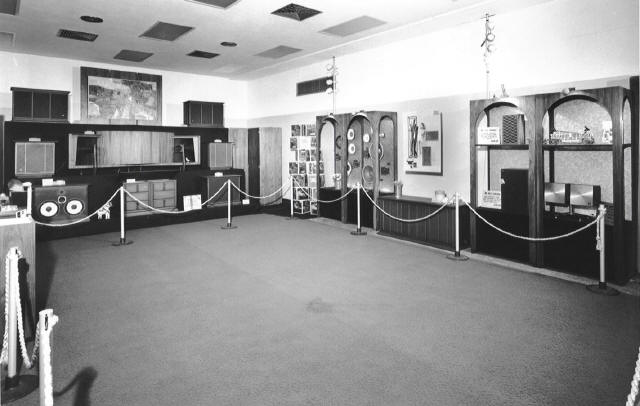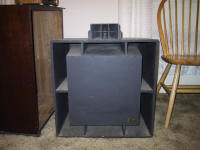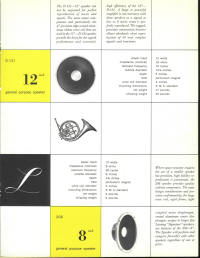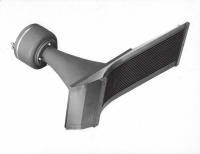|
|
|||||||||||

|
|
||||||||||
Remarkable legacy
|
|||||||||||
|
JBL Product Demonstration Circa 1970 |
|||||||||||
|
In considering the growth of JBL during the decade of the seventies, it must be emphasized that all of the elements that were to characterize the company were put firmly in place by William H. Thomas and his associates. Drawing on the seminal work of James B. Lansing, Thomas set about refining and expanding the transducer product line in significant ways. In this endeavor he was assisted by Bart Locanthi, a physicist trained at the California Institute of Technology, and by Edmond May, a transducer and systems engineer long recognized in the industry (some audiophiles may recall the unusual Frasier-May loudspeaker system produced in the 1950s when May had his own company). Drawing on original research done in the 1949 by Winston Kock of Bell Laboratories and the acoustical lens configurations devised by John Frayne (while working at Westrex in the 1950s), Locanthi was able to take the concept further. The result was his remarkable series of lens designs for use with various horn/compression driver assemblies. It is believed that the slant-plate lens was entirely Locanthi's creation. He was also centrally responsible for the Linear Efficiency series of cone transducers and, later, for the unique "T" circuitry used in JBL electronic products. Ed May's unusual ability to translate engineering concepts into usable hardware was of immense practical value in the development of numerous loudspeaker products.
The growing public awareness of JBL as an innovator in the high-fidelity industry was largely the product of the hard work done by Thomas and Ray Pepe, his Vice President of Marketing. The two of them were indefatigable in making visits to retail dealers all over the U.S., convincing the fledgling trade of the superiority of JBL's products, distribution and warranty policies. Little is known about Pepe's background save for the arresting fact that he once served as Comptroller in the New York City administration of Fiorello LaGuardia. He was able to use his wide acquaintanceship with personalities in the media to obtain favorable publicity for JBL “ most notably, his friendship with A.C. Spectorsky, the associate publisher of "Playboy" magazine, resulted in a number of very effective mentions and product placements in that publication. The consumer advertising during this time was almost entirely "institutional;" that is, devoted to establishing the name of the company and its image as the pre-eminent manufacturer of loudspeakers of the highest possible quality and durability. Most of the ads featured a striking photograph of some rare musical instrument, conveying the clear implication that a JBL loudspeaker deserved the same recognition for excellence. While expanding the domestic dealer network, Thomas and Pepe also understood the importance of the international market. Their efforts in Europe and South America were greatly aided by Ernest Wetzig, an expatriate German-Swiss national, whose command of languages and international trading procedures was considerable. The Japanese market, which was to prove remarkably fertile, was initially developed by Thomas and Pepe. They soon discovered that the postwar Japanese public held all products of American technology in almost reverential esteem and, as income levels rose with the general economic recovery of the country, JBL's unique products gained an enormous following. One story, reported by Arnold Wolf and possibly apocryphal, is that a wealthy Japanese physician owns every enclosed system ever produced by JBL, including several Paragons “ one finished in black lacquer.
One of Bill Thomas's most remarkable insights from the very start of the enterprise was that good design of every point of visual contact with the public was a vital ingredient in establishing and keeping the company's reputation for unquestioned quality. No one seems to know where Thomas acquired his sensitivity to design or his awareness of its subjective power to influence perception. The best clue lies in his early friendship with Alvin Lustig, one of the most brilliant and versatile designers to emerge from the World War II era. Arnold Wolf recalls Thomas speaking admiringly of Lustig: "He would not waste any words on you if he felt you weren't interested. But, if you demonstrated genuine interest in a design, he would spend all the time in the world to explain the aesthetics and subjective significance of what he was trying to do." A number of the earliest JBL enclosures were designed by Lustig, including the C34, C35 Fairfield, C36 Viscount, C37 Rhodes, C38 Baron, and the C40 Harkness. Some of the first literature graphics prepared by JBL were also Lustig designs. Wolf has stated that, although he met Lustig only once (in 1944), he has always felt influenced by the older designer. In addition to the exemplary standard set by Lustig's work, both men had attended Los Angeles City College and were exposed to the same instructors, albeit several years apart. The Thomas-Lustig collaboration eventually was attenuated because of the many demands placed on the designer's time by his growing list of clients. Sadly, even that diminished relationship was tragically cut short by Lustig's blindness and early death due to acute diabetes. Another important contributor to JBL's unmistakable design presence was Roger Kennedy, whose visual creativity set the tone for the company's graphics starting in the mid-1950s and continuing for the next thirty years.
Bill Thomas was always interested in making JBL an important player in the professional sound arena, but it was difficult to find a way past the dominance exerted by Altec Lansing. Starting with Altec's inheritance of the contracts held by Western Electric for motion picture sound recording and reproduction, the older firm continued to enjoy a virtual monopoly on theater systems maintenance and, ultimately, on the supply of new products to the industry. Despite Altec's historical advantage, JBL's development of the 375 compression driver (in 1953) and various associated horns and acoustic lenses gained the company entry into the theater business by means of agreements reached with the Ampex Corporation and Westrex, the export division of Western Electric. Expanding contacts with the very active sound recording industry centered in Los Angeles (for both the record business and TV/motion picture scoring) led inevitably to the development of the Studio Monitor series of reproducers. Curiously enough, another important opening for JBL into the professional sound market was prompted by the rise of rock-and-roll music in the late 1950s. The increasing demand by rock-and-roll bands for better loudspeakers that could sustain the power-handling requirements of their musical style and which would also offer solo players the highly sought but elusive quality of "presence" led almost at once to widespread use of JBL transducers. Leo Fender noted this trend and soon incorporated the D-130 15" loudspeaker into his amplified guitar systems. The accompanying need for very heavy sound reinforcement at rock concerts “ which were often held in stadium or arena venues “ brought a further natural expansion in the use of JBL's products for these professional applications. In sum, the essential character and direction of JBL was well in place by the time the company was sold, in 1969, to the Jervis Corporation “ the event that heralded the era of corporate leadership by Sidney Harman and the presidency of Arnold Wolf. © 2001 Arnold Wolf |
|||||||||||











